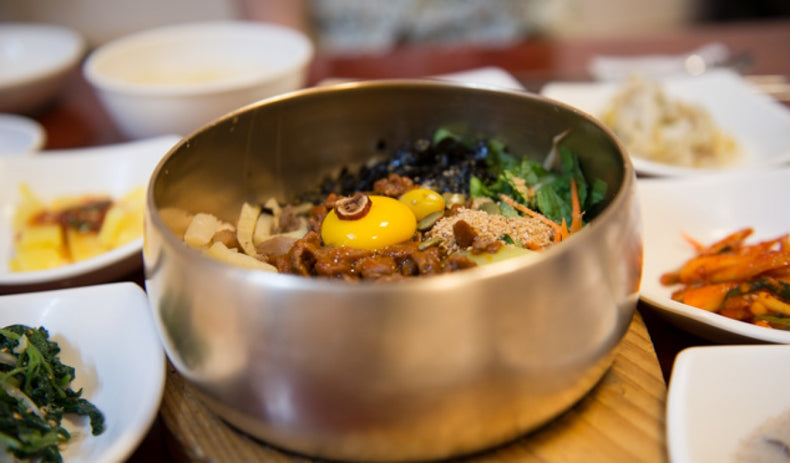The Beginner's Guide To Bibimbap - Step-by-Step Recipe

Bibimbap or bibim-bap is one of Korea's most famous meals. A form of bibimbap is almost always served on long haul flights to and from Korea, giving a taste of what is to come, or to remind you of what you are leaving. 'Bibim' means mixed, 'bap' means rice, and the dish is exactly that - a layer of rice, with a variety of meat and vegetable toppings, stirred together at the table.
Bibimbap can be served in a searingly hot stone bowl (a dolsot) making it crisp, other times a large brass or stainless steel bowl. Recipes vary from region to region, though the dish is instantly recognisable by the large bowl and colourful ingredients.
The colours of bibimbap
Most important in bibimbap recipes are the five different colours, symbolic in Orientalism. For food to be in harmony or balance a little of each colour is eaten at the same meal - each representing either a different part of the body, or a different point of the compass.
Black or dark colours represent North and the kidneys. Foods can be shiitake mushrooms, bracken ferns or nori seaweed. Red or orange represents South and the heart, with chilli, carrots and jujube dates. Green represents East and the liver, with cucumber and spinach. White is West or the lungs, with foods which include beansprouts, radish, and rice. And finally yellow represents the centre, or stomach. Foods include pumpkin, potato or egg.

Dolsot bibimbap, served in a searingly hot traditional stone bowl, with bracken ferns and the classic fried egg on top
Regional variations
Bibimbap is highly regional. Jeonju, South of Seoul, with sunny weather and a good climate for agriculture, is famed for its cattle. The bibimbap is topped with raw beef and a raw egg yolk - not dissimilar to French steak tartare. The rice can be cooked in beef broth, and served with a bean sprout soup.

Bibimbap in jeonju with raw beef and topped with an egg yolk. The dish is surrounded with 'banchan' which are small vegetables side dishes to accompany the main course.
Andong in the east is home to the Andong Dosan Seowon Confucian Monastery, and the bibimbap is adjusted to suit the Confucian diet. Meals must be vegetarian with no pungent ingredients, such as garlic or chilli, to prevent stimulation. Red food is also avoided as the colour is thought to scares ghosts away. As the gochujang red chilli paste cannot be used, sauces are soy based or made using doenjang fermented bean paste .Food prepared for ceremonies earlier in the day can be used as toppings.
Busan in the south-east is home to the largest wet fish market in South Korea and has a thriving port. As you might expect the bibimbap often includes fish or seafood, and the sauce tends to be a vinegared gochujang to bring a light acidity to the dish.

Squid and tobiko roe bibimbap with fresh salad leaves – the type of bibimbap you might expect to find in Busan, although this one was in Seoul
North Korea has a colder climate than South Korean and in Heaju, over the border, the bibimbap is heavier and richer. The rice is fried in pork fat and served with a pork blood soup.
Preparing bibimbap
Bibimbap can be simple or extremely elaborate. 'Royal' bibimbap may have 30 or more different ingredients, each of which are prepared separately. However, typically vegetable garnishes are lightly fried in a little oil and salt, and seasoned with one or more of soy sauce, sesame oil and garlic. Shiitake mushrooms may be marinated first in soy sauce, sesame oil and garlic; beef is left in a similar marinade, with a little sugar. Bibimbap is usually topped with a fried egg, but a raw egg yolk (or whole egg) can also be used. The raw egg tends to be better with dolsot bibimbap where the hot bowl cooks the egg through.
Instead of preparing ingredients fresh, bibimbap is also an excellent vehicle for using up leftovers - toppings could include anything from steamed carrots to a tomato salad.
Sauces can vary. Gochujang alone is the simplest and most common, but a thinner gochujang mixed with vinegar or herbed soy sauce are often used. For a far more elaborate 'King's bibimbap' the gochujang is mixed with many more ingredients including luxurious ground beef, chopped garlic, sugar, spring onions, soy sauce and pear juice.


